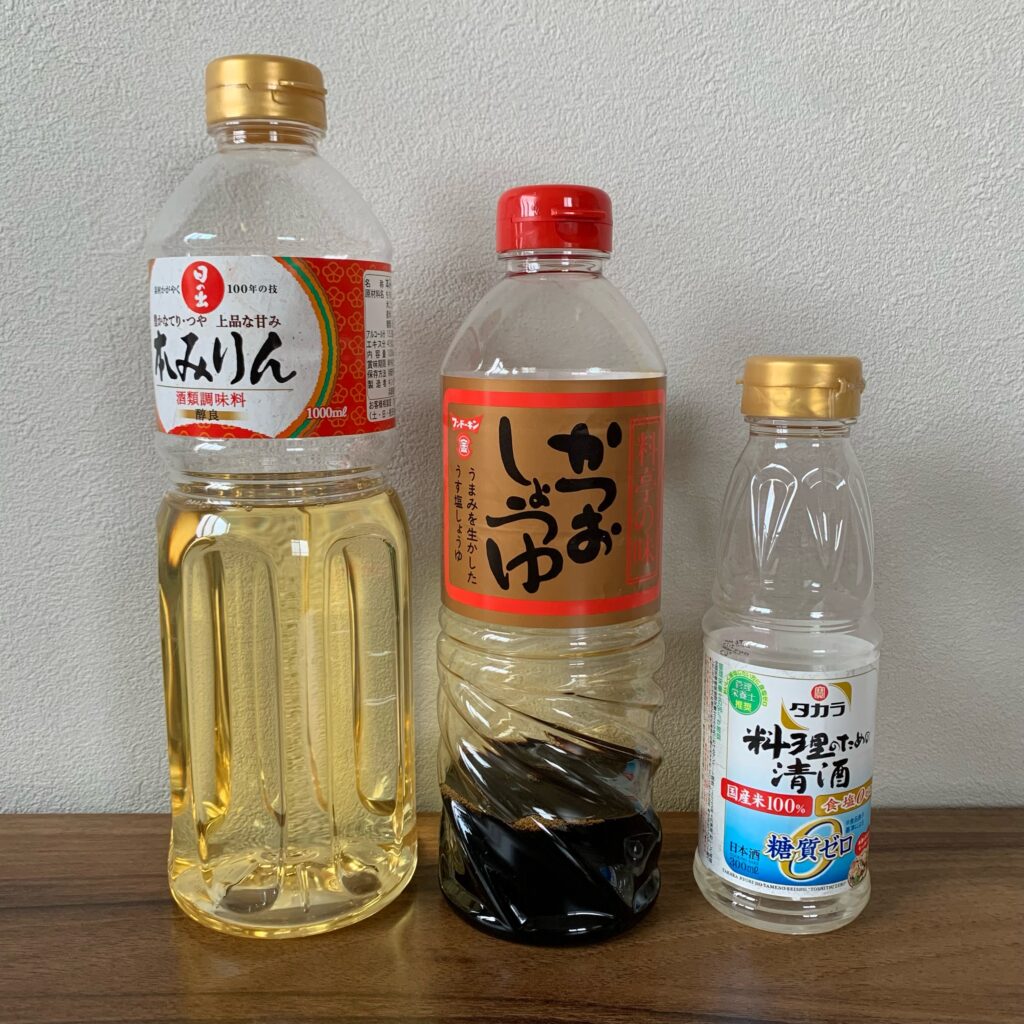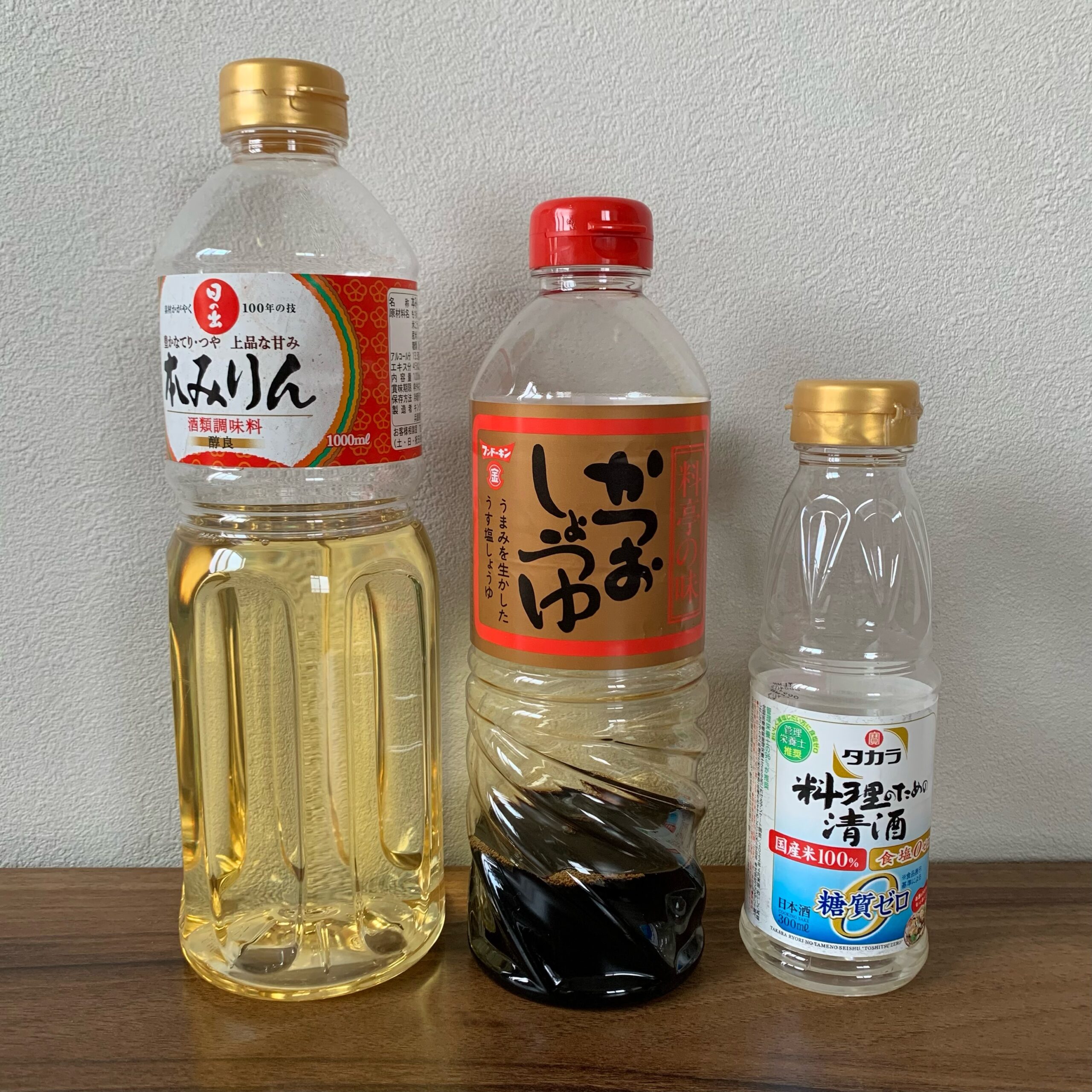
This article is about soy sauce, mirin, and sake, which are essential to Japanese cuisine.
What kind of food is soy sauce??
The main raw material is grains such as soybeans. It is a liquid seasoning made by adding koji and salt to the main ingredients and fermenting and aging it.
The most common types include ”koikuchi soy sauce=dark soy sauce“,”usukuchi soy sauce=Light soy sauce“, which originated in the Kansai region, and “Tamari soy sauce”,which is mainly made in the Tokai region.
The ingredients for koikuchi soy sauce are soybeans, wheat, salt, water, and koji mold.
Soybeans soaked in water are steamed until soft, and wheat is roasted and crushed. Mix soybeans and wheat, sprinkle with koji mold, and leave in a warm room. After about three days, it is called soy sauce koji.
(Koji mold is an essential microorganism in Japanese fermented foods such as miso, soy sauce, mirin, rice vinegar, amazake, sake, and shochu.)
When soy sauce koji is mixed with salt water, it becomes something called moromi. Moromi looks like miso with a lot of water. Moromi is fermented and aged using the power of lactic acid bacteria and koji mold.
The protein in soybeans is converted into amino acids, and the starch in wheat is converted into glucose. This is how the umami and aroma components of soy sauce are created.
We squeeze moromi that has been made over a long period of over half a year. The squeezed liquid is heated and shipped as soy sauce.
Soy sauce, which was nurtured by the climate and culture of Japan, is now loved all over the world.
What kind of food is mirin??
An alcoholic beverage made from glutinous rice, rice malt, and shochu, it is widely used as a seasoning. It is an essential ingredient in Japanese cuisine, along with soy sauce and miso.
Hon mirin: It has a high alcohol content of 14% and is classified as an alcoholic beverage under the Liquor Tax Law. It has a unique sweetness and richness, and is said to have the effect of removing odors from the ingredients and making it easier for the flavors to absorb. It also prevents the ingredients from collapsing when cooked and locks in the umami flavor. Since alcohol has a strong aroma, it is better to heat it in a pot when using it for dishes that do not require heating.
Mirin-style seasoning: A mixture of sugars such as glucose and starch syrup, glutamic acid, and flavoring. Alcohol content is less than 1%. Because it is treated as a seasoning, it is distributed at a lower price than Hon Mirin. However, it does not have the effects derived from alcohol, such as removing odors and preventing spoilage.
Fermented seasoning: Since it contains 8-20% alcohol, it can also be used to remove odors. Because it has been adjusted by adding salt, it cannot be considered an alcoholic beverage.
What kind of food is sake ??
There are three main types of sake used in cooking. Seishu, sake for cooking(without salt), and sake for cooking(with salt).
The Liquor Tax Law requires that salt be added to sake for cooking to make it unfit for drinking.
Compared to sake for cooking (without salt), seishu is much tastier and more expensive.
Products with added salt are not subject to liquor tax, so they can be purchased at a low price. It contains the same amount of salt as seawater.
Sake is made by fermenting rice malt and water with the help of yeast. Enzymes in rice malt break down rice starch into sugar, and yeast eats the sugar, producing amino acids and organic acids that are the source of alcohol and umami.
- *Removes fishy smell from food
- *Make it easier for the flavor to soak in
- *Softens ingredients
- *Adds richness and flavor
- * Locks in the flavor of ingredients
Sake is said to have the above effects.
しょうゆってどんな食材?
主原料は大豆などの穀物です。 主原料に麹と塩を加えて発酵・熟成させた液体調味料です。
代表的なものには、関西発祥の「濃口醤油」、関西発祥の「薄口醤油」、東海地方を中心に作られる「たまり醤油」があります。
濃口醤油の原材料は、大豆、小麦、食塩、水、麹です。 水に浸した大豆を柔らかくなるまで蒸し、小麦を煎って砕きます。 大豆と小麦を混ぜ、麹菌をまぶして暖かい部屋に置きます。 3日ほど経ったものを醤油麹といいます。
(麹菌は、味噌、醤油、みりん、米酢、甘酒、日本酒、焼酎などの日本の発酵食品に欠かせない微生物です。)
醤油麹を塩水と混ぜるともろみと呼ばれるものになります。 もろみは水分の多い味噌のようです。 もろみは乳酸菌と麹菌の力で発酵・熟成されます。 大豆のたんぱく質はアミノ酸に、小麦のでんぷんはブドウ糖に変わります。 こうして醤油の旨味成分や香り成分が生まれます。 半年以上の長い期間をかけて造られたもろみを搾ります。 搾った液を加熱して醤油として出荷します。
日本の風土と文化が育んだしょうゆは、今や世界中で愛されています。
みりんってどんな食材?
もち米、米麹、焼酎から作られるお酒で、調味料として広く使われています。 醤油や味噌と並んで日本料理には欠かせない食材です。
本みりん:アルコール度数が14%と高く、酒税法では酒類に分類されます。 独特の甘みとコクがあり、食材の臭みを消して味を染み込ませやすくする効果があるといわれています。 煮崩れを防ぎ、旨みを閉じ込めます。 アルコールは香りが強いので、加熱の必要のない料理に使用する場合は鍋で加熱した方が良いでしょう。
みりん風調味料:ぶどう糖や水飴などの糖類、グルタミン酸、香料などを混合したもの。 アルコール分は1%未満です。 調味料として扱われるため、本みりんよりも安価で流通しています。 ただし、臭いを消したり、腐敗を防ぐなど、アルコール由来の効果はありません。
発酵調味料:アルコールが8~20%含まれているので、臭い消しにも使えます。 食塩を加えて調整しているため、酒類には該当しません。
酒ってどんな食材?
料理に使われる日本酒は主に3種類あります。 清酒、無塩料理用酒、塩料理用酒です。
酒税法では、調理用の日本酒に食塩を添加して飲用に適さないようにすることを義務付けています。
料理用の酒(無塩)に比べて、清酒ははるかに美味しく、高価です。
食塩を添加した商品は酒税がかからないため、安価に購入できます。 これには海水と同じ量の塩分が含まれています。
日本酒は米麹と水を酵母の働きで発酵させて作られます。 米麹の酵素が米のでんぷんを糖に分解し、酵母がその糖を食べてアルコールや旨味の素となるアミノ酸や有機酸を生成します。
- 食品の生臭みを取り除く
- 味が染み込みやすくなる
- 食材を柔らかくする
- コクと風味を加える
- 素材の旨みを閉じ込める
日本酒には上記のような効果があると言われています。



コメント